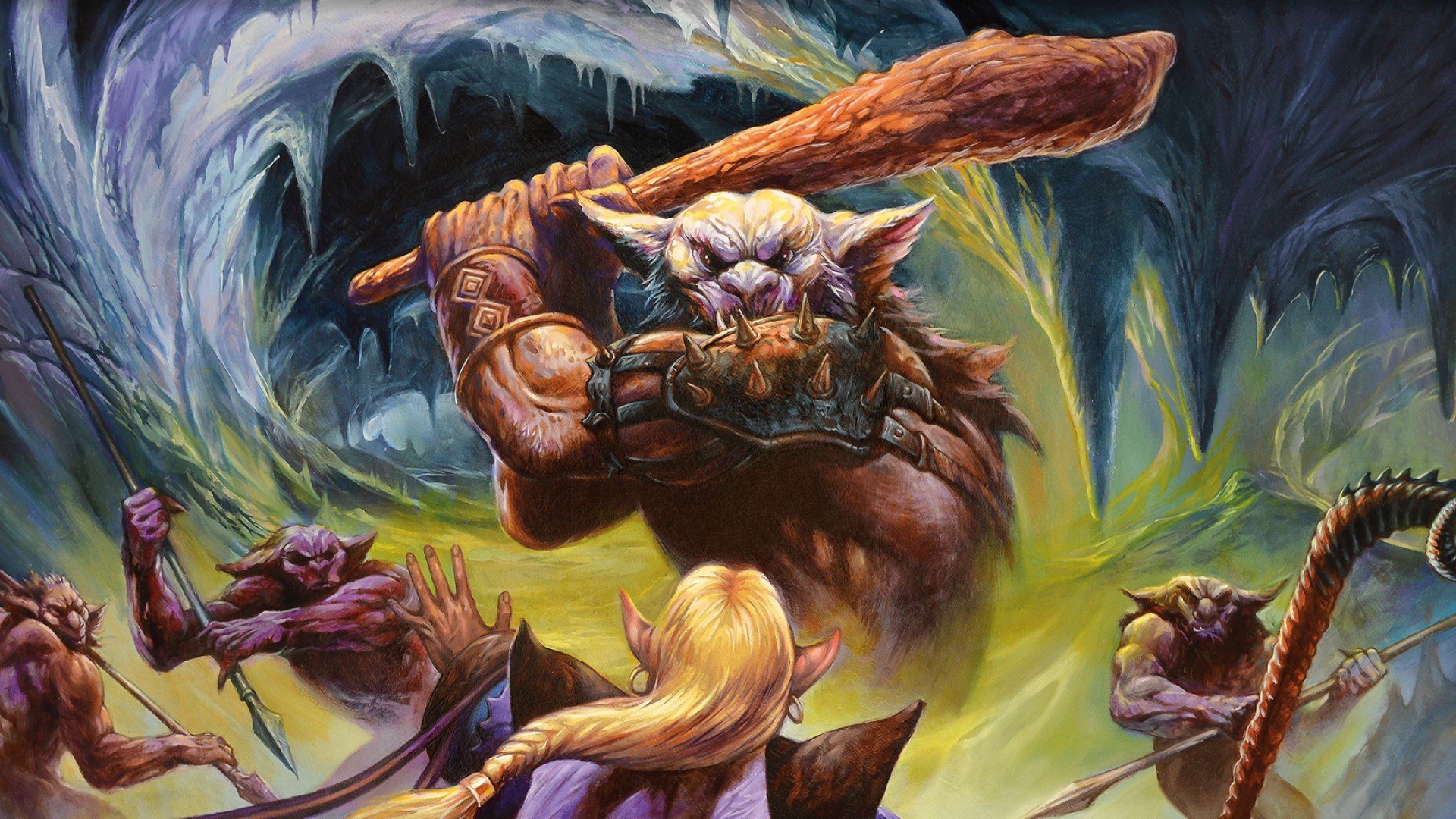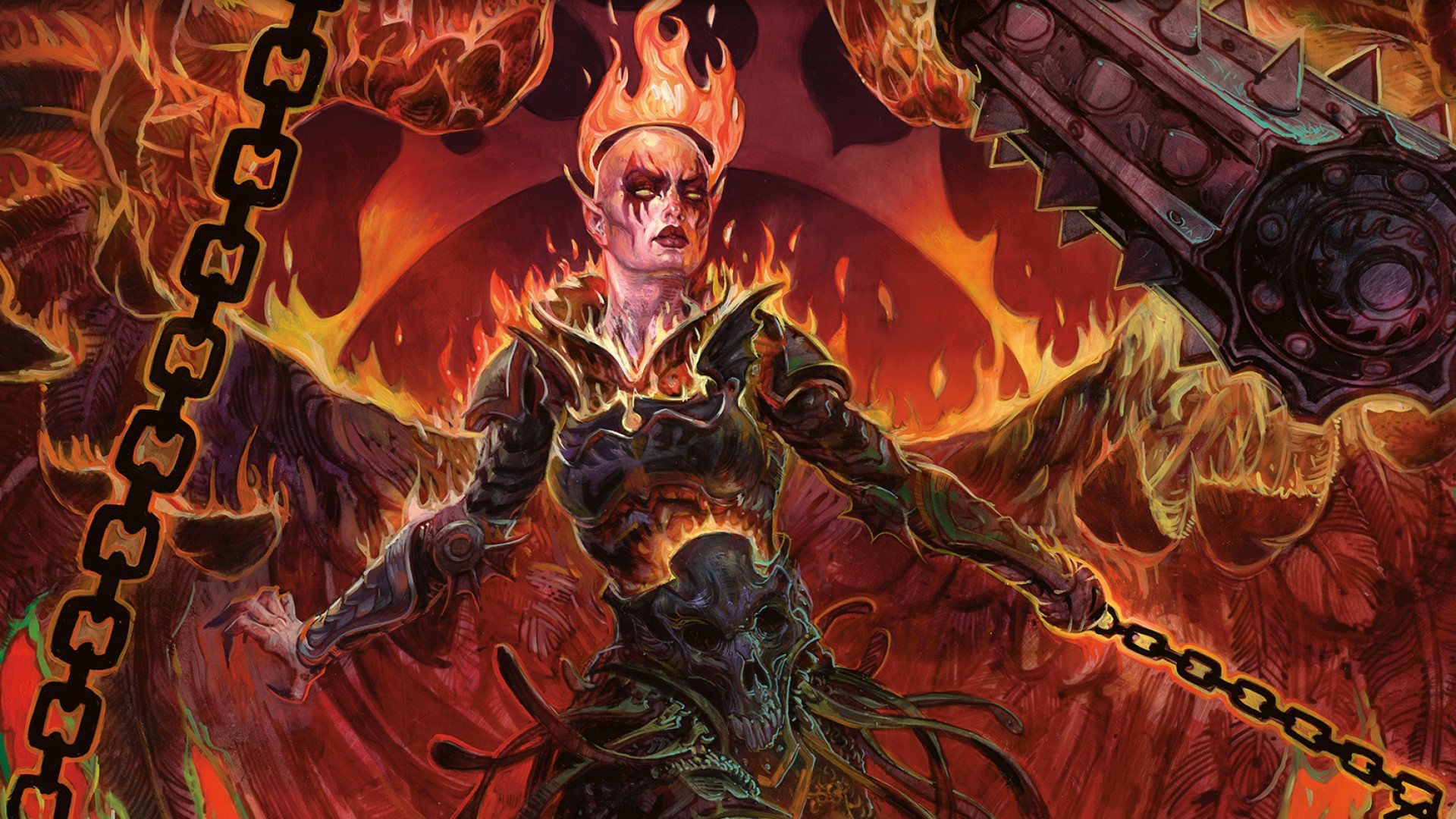Embark on an enchanting journey through the realm of dnd languages 5e, where words hold power, shape identities, and bridge cultural divides. This comprehensive guide unveils the intricate tapestry of languages that enrich the Dungeons & Dragons experience, empowering players and Dungeon Masters alike to create immersive and captivating campaigns.
From the familiar Common tongue to the ancient Draconic script, discover the diverse range of languages that populate the D&D universe. Delve into the mechanics of language proficiency, unlocking the secrets of how characters master different tongues. Explore the profound impact languages have on roleplaying, worldbuilding, and the challenges they present for adventurers.
Languages in D&D 5e: Dnd Languages 5e

Languages play a vital role in Dungeons & Dragons 5th Edition, facilitating communication among characters, unlocking hidden lore, and enhancing role-playing experiences. D&D 5e offers a diverse range of languages, each with its unique characteristics and significance in the game world.
Languages in D&D 5e can be broadly classified into two types: Common and Exotic. Common languages are widely spoken and understood across multiple regions, while Exotic languages are typically associated with specific races, cultures, or organizations.
Common Languages
Common languages are the most prevalent in the D&D world and serve as the lingua franca for communication between different races and cultures. They include:
- Common: The default language of the D&D world, spoken by most humanoids, including humans, elves, dwarves, halflings, and gnomes.
- Elvish: The language of the elven race, known for its elegance and lyrical quality.
- Dwarvish: The language of the dwarven race, characterized by its guttural and earthy tones.
- Giant: The language of the giant race, known for its booming and intimidating sound.
- Goblin: The language of the goblin race, often associated with crude and guttural speech.
- Halfling: The language of the halfling race, characterized by its cheerful and lighthearted tone.
- Orc: The language of the orc race, known for its harsh and guttural sound.
Creating Custom Languages

Creating custom languages can enrich your D&D 5e campaign by providing unique and immersive experiences for players. This guide will provide guidance on developing custom alphabets, grammar, and vocabulary, as well as examples of well-designed languages.
Developing Unique Alphabets
An alphabet is a set of symbols used to represent the sounds of a language. When creating a custom alphabet, consider the following:
-
-*Phonology
The sounds used in your language. Determine the vowels, consonants, and diphthongs (combinations of vowels).
-*Script
The visual representation of your alphabet. Design unique symbols that are visually distinct and easy to read.
-*Inspiration
Draw inspiration from existing alphabets, such as Latin, Cyrillic, or Japanese, to create a familiar yet distinct look.
Establishing Grammar, Dnd languages 5e
Grammar defines the rules for combining words and phrases in a language. When developing grammar, consider:
-
-*Syntax
The order in which words are arranged in sentences.
-*Morphology
The way words are formed and modified using prefixes, suffixes, and other grammatical elements.
-*Phonology
How sounds are combined and modified in different grammatical contexts.
Creating Vocabulary
Vocabulary refers to the words used in a language. When creating vocabulary, consider:
-
-*Semantic Fields
Group words into categories, such as nouns, verbs, adjectives, and adverbs.
-*Etymology
Provide a backstory for your words, explaining their origins and meanings.
-*Influence
Draw inspiration from real-world languages or invent entirely new words.
Examples of Custom Languages
Well-designed custom languages can greatly enhance gameplay. Here are some examples:
-
-*Elvish
A melodic and elegant language used by elves, known for its intricate grammar and poetic expressions.
-*Dwarvish
A guttural and earthy language spoken by dwarves, characterized by its emphasis on craftsmanship and mining terminology.
-*Undercommon
A common tongue used by subterranean races, featuring a mix of Dwarvish, Elvish, and other languages.
Language Proficiency
Language proficiency in D&D 5e is a measure of a character’s ability to understand and communicate in a particular language. Proficiency levels range from none to full fluency.
Characters can learn and become proficient in different languages through various methods, including study, practice, and immersion in a culture that speaks the language. Proficiency in a language grants several benefits, including the ability to read and write in the language, understand spoken language, and communicate effectively with speakers of that language.
Incorporating Language Proficiency into Roleplaying and Storytelling
Incorporating language proficiency into roleplaying and storytelling can add depth and realism to your game. Consider the following tips:
- Use language proficiency to create challenges and obstacles:Characters who are not proficient in a particular language may face difficulties communicating with NPCs or understanding important information.
- Reward players for learning new languages:Granting players bonuses or advantages for becoming proficient in new languages can encourage them to invest in their characters’ linguistic abilities.
li> Use language proficiency to develop character backstories and motivations:The languages a character speaks can provide insight into their past experiences and motivations.
Languages and Roleplaying
In the realm of Dungeons & Dragons, languages play a pivotal role in enriching the roleplaying experience. They provide a means to create immersive settings, develop memorable characters, and navigate the challenges presented by language barriers.
Creating Immersive Settings
Languages can transport players into distinct cultural and geographical regions. By incorporating local dialects, accents, and unique words, Dungeon Masters can craft settings that feel authentic and lived-in. For example, an elven forest might have a melodious language filled with nature-inspired imagery, while a dwarven city could boast a guttural tongue that reflects their industrious nature.
Developing Memorable Characters
Languages can also be used to flesh out characters and make them more relatable. By choosing appropriate languages for different characters, players can create unique personalities and motivations. A cunning rogue who speaks several languages may have a cosmopolitan background, while a reclusive hermit might be limited to a single, ancient tongue.
Overcoming Language Barriers
Language barriers can present significant challenges for adventurers. When characters encounter individuals who speak different languages, communication can become difficult or impossible. This can lead to misunderstandings, misinterpretations, and even conflict. However, overcoming these barriers can also be a rewarding experience, as it fosters cooperation and understanding between different cultures.
Language and Worldbuilding

Languages in D&D 5e can play a vital role in enhancing the depth and immersion of your campaign world. By creating distinct and believable language systems, you can bring your world to life and provide players with a rich tapestry of cultural identities, historical events, and geographical regions to explore.
Cultural Identities
Languages can serve as a reflection of the cultural identities of different societies within your world. Each language can carry unique vocabulary, grammar, and syntax that reflect the values, beliefs, and traditions of its speakers. For example, a society that values honor and bravery might have a language that emphasizes words related to combat and valor, while a society that values wisdom and knowledge might have a language that is rich in philosophical terms and proverbs.
Historical Events
Languages can also bear witness to the historical events that have shaped your world. The evolution of a language over time can reflect changes in political boundaries, cultural influences, and technological advancements. By incorporating historical events into your language systems, you can create a sense of depth and realism in your campaign world.
Geographical Regions
Languages can vary significantly across different geographical regions, reflecting the influence of climate, terrain, and cultural interactions. For example, a language spoken in a mountainous region might have words for different types of rock formations and weather conditions, while a language spoken in a coastal region might have words for different types of boats and fishing techniques.
Importance of Consistency
When creating language systems for your campaign world, it is important to ensure that they are consistent and believable. This means developing a clear set of rules for grammar, syntax, and vocabulary. It also means considering how languages interact with each other, such as through trade, diplomacy, or conquest.
By creating consistent and believable language systems, you can enhance the immersion of your players and make your campaign world feel more real and alive.
Language Resources
Enhancing your D&D 5e games with languages requires access to reliable resources. Whether you’re a player seeking to develop a rich backstory or a DM striving to create an immersive world, utilizing language resources can elevate your gameplay experience.
From online language generators to comprehensive dictionaries, various tools are available to support your linguistic endeavors. Embracing these resources allows you to explore the depths of language, ensuring authenticity and adding a layer of depth to your D&D sessions.
Online Language Generators
Harness the power of online language generators to create unique and captivating languages for your D&D world. These tools enable you to generate alphabets, grammar rules, and even vocabulary, providing a solid foundation for your linguistic creations.
- Fantasy Name Generators:Generate unique and evocative names for your characters, locations, and languages.
- Conlang Generator:Create complete languages with customizable alphabets, grammar, and vocabulary.
- Medieval Fantasy Language Generator:Generate languages inspired by medieval and fantasy settings.
Final Summary
As you delve deeper into the linguistic landscape of D&D 5e, you’ll uncover a treasure trove of resources to enhance your gameplay. Utilize online language generators, consult comprehensive dictionaries, and embrace the power of language to craft truly unforgettable adventures.
Let the words flow, shaping the destiny of your characters and the worlds they inhabit.
Clarifying Questions
What is the most commonly spoken language in D&D 5e?
Common is the most widespread language, spoken by humans, halflings, and most other humanoid races.
Can characters learn new languages during a campaign?
Yes, characters can learn new languages through study, immersion, or magical means.
How does language proficiency affect gameplay?
Proficient characters can read, write, and speak a language, gaining advantages in communication, understanding texts, and deciphering ancient inscriptions.